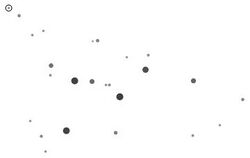Astronomy:Pi Cassiopeiae
| Observation data Equinox J2000.0]] (ICRS) | |
|---|---|
| Constellation | Cassiopeia |
| Right ascension | 00h 43m 28.07045s[1] |
| Declination | +47° 01′ 28.3694″[1] |
| Apparent magnitude (V) | +4.949[2] |
| Characteristics | |
| Spectral type | A5V[3] + A5V[4] |
| B−V color index | +0.171[2] |
| Variable type | Ellipsoidal[5] |
| Astrometry | |
| Radial velocity (Rv) | +12.9±0.8[6] km/s |
| Proper motion (μ) | RA: −23.71±0.23[1] mas/yr Dec.: −36.84±0.18[1] mas/yr |
| Parallax (π) | 18.63 ± 0.32[1] mas |
| Distance | 175 ± 3 ly (53.7 ± 0.9 pc) |
| Absolute magnitude (MV) | +1.30[7] |
| Orbit[8] | |
| Period (P) | 1.9642 d |
| Eccentricity (e) | 0.00 |
| Periastron epoch (T) | 2427535.74 JD |
| Argument of periastron (ω) (secondary) | 0.00° |
| Semi-amplitude (K1) (primary) | 120.5 km/s |
| Semi-amplitude (K2) (secondary) | 122.1 km/s |
| Details | |
| A | |
| Mass | 1.82[9] M☉ |
| Radius | 1.9[4] R☉ |
| Luminosity | 22[10] L☉ |
| Surface gravity (log g) | 4.41[11] cgs |
| Temperature | 8,392±285[11] K |
| Rotational velocity (v sin i) | 60[4] km/s |
| Age | 251[11] Myr |
| B | |
| Mass | 1.87[9] M☉ |
| Radius | 1.9[4] R☉ |
| Rotational velocity (v sin i) | 65[4] km/s |
| Other designations | |
| Database references | |
| SIMBAD | data |
Pi Cassiopeiae, Latinized from π Cassiopeiae, is a close binary star[8] system in the constellation Cassiopeia. It is visible to the naked eye with an apparent visual magnitude of +4.949.[2] Based upon an annual parallax shift of 18.63 mas as seen from Earth,[1] this system is located about 175 light years from the Sun.
This is a double-lined spectroscopic binary system with an orbital period of nearly two days in a circular orbit.[8] It is classified as a rotating ellipsoidal variable star and its brightness varies by 0.02 magnitudes with a period of 23.57 hours,[5] which equals half of its orbital period. The spectrum matches that of an A-type main-sequence star with a stellar classification of A5 V.[3] The two stars have similar masses and spectra.[4] A star at a projected separation of 1,700 astronomical unit|AU has been identified as a possible white dwarf. It is at the same distance as Pi Cassiopeiae and shares a common proper motion. The age of the white dwarf is calculated to be about 500 million years.[14]
Pi Cassiopeiae has been given the spectral class of kA3hF1mA5, indicating an Am star,[15] but this is now considered doubtful.[16]
References
- ↑ 1.0 1.1 1.2 1.3 1.4 1.5 van Leeuwen, F. (2007), "Validation of the new Hipparcos reduction", Astronomy and Astrophysics 474 (2): 653–664, doi:10.1051/0004-6361:20078357, Bibcode: 2007A&A...474..653V.
- ↑ 2.0 2.1 2.2 Høg, E. et al. (2000), "The Tycho-2 catalogue of the 2.5 million brightest stars", Astronomy and Astrophysics 355: L27, doi:10.1888/0333750888/2862, Bibcode: 2000A&A...355L..27H.
- ↑ 3.0 3.1 Cowley, A. et al. (April 1969), "A study of the bright A stars. I. A catalogue of spectral classifications", Astronomical Journal 74: 375–406, doi:10.1086/110819, Bibcode: 1969AJ.....74..375C.
- ↑ 4.0 4.1 4.2 4.3 4.4 4.5 Howe, K. S.; Clarke, C. J. (2009). "An analysis of v sin (I) correlations in early-type binaries". Monthly Notices of the Royal Astronomical Society 392 (1): 448. doi:10.1111/j.1365-2966.2008.14073.x. Bibcode: 2009MNRAS.392..448H.
- ↑ 5.0 5.1 Samus, N. N. et al. (2017), "General Catalogue of Variable Stars", Astronomy Reports, GCVS 5.1 61 (1): 80–88, doi:10.1134/S1063772917010085, Bibcode: 2017ARep...61...80S.
- ↑ de Bruijne, J. H. J.; Eilers, A.-C. (October 2012), "Radial velocities for the HIPPARCOS-Gaia Hundred-Thousand-Proper-Motion project", Astronomy & Astrophysics 546: 14, doi:10.1051/0004-6361/201219219, A61, Bibcode: 2012A&A...546A..61D.
- ↑ Anderson, E.; Francis, Ch. (2012), "XHIP: An extended hipparcos compilation", Astronomy Letters 38 (5): 331, doi:10.1134/S1063773712050015, Bibcode: 2012AstL...38..331A.
- ↑ 8.0 8.1 8.2 Pourbaix, D. et al. (2004), "SB9: The Ninth Catalogue of Spectroscopic Binary Orbits", Astronomy & Astrophysics 424: 727–732, doi:10.1051/0004-6361:20041213, Bibcode: 2004A&A...424..727P.
- ↑ 9.0 9.1 Vallenari, A. et al. (2022). "Gaia Data Release 3. Summary of the content and survey properties". Astronomy & Astrophysics. doi:10.1051/0004-6361/202243940 Gaia DR3 record for this source at VizieR.
- ↑ McDonald, I. et al. (2012), "Fundamental Parameters and Infrared Excesses of Hipparcos Stars", Monthly Notices of the Royal Astronomical Society 427 (1): 343–57, doi:10.1111/j.1365-2966.2012.21873.x, Bibcode: 2012MNRAS.427..343M.
- ↑ 11.0 11.1 11.2 David, Trevor J.; Hillenbrand, Lynne A. (2015), "The Ages of Early-Type Stars: Strömgren Photometric Methods Calibrated, Validated, Tested, and Applied to Hosts and Prospective Hosts of Directly Imaged Exoplanets", The Astrophysical Journal 804 (2): 146, doi:10.1088/0004-637X/804/2/146, Bibcode: 2015ApJ...804..146D.
- ↑ "pi. Cas". SIMBAD. Centre de données astronomiques de Strasbourg. http://simbad.u-strasbg.fr/simbad/sim-basic?Ident=pi.+Cas.
- ↑ "MAST: Barbara A. Mikulski Archive for Space Telescopes". Space Telescope Science Institute. https://mast.stsci.edu/portal/Mashup/Clients/Mast/Portal.html.
- ↑ Qiu, Dan; Tian, Hai-Jun; Wang, Xi-Dong; Nie, Jia-Lu; von Hippel, Ted; Liu, Gao-Chao; Fouesneau, Morgan; Rix, Hans-Walter (2021). "Precise Ages of Field Stars from White Dwarf Companions in Gaia DR2". The Astrophysical Journal Supplement Series 253 (2): 58. doi:10.3847/1538-4365/abe468. Bibcode: 2021ApJS..253...58Q.
- ↑ Abt, Helmut A.; Morrell, Nidia I. (1995). "The Relation between Rotational Velocities and Spectral Peculiarities among A-Type Stars". Astrophysical Journal Supplement Series 99: 135. doi:10.1086/192182. Bibcode: 1995ApJS...99..135A.
- ↑ Renson, P.; Manfroid, J. (2009). "Catalogue of Ap, HGMN and Am stars". Astronomy and Astrophysics 498 (3): 961. doi:10.1051/0004-6361/200810788. Bibcode: 2009A&A...498..961R.
 |



